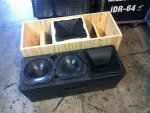Re: New DIY Mid High
The standard BMS I think will still cost about 750 each. The HE version a simple 1000 each. Something closer to 3-400 each for the CD is doable for me. I will not be thinking that any of these lesser options will compare to the HE BMS CD. I am just trying to get the highs accomplished by a lesser product. Then down the road I can save more money and buy the BMS AND better DSP.
I was looking at the 12PE32 for another design anyways. AND your design seems to be the best horn loaded design I could find for the size. I just cant afford the mid/high combo. I also was looking at the XT horn because I could not find a 90 degree horn such as we had discussed.
Was also curious about the Radian 950/850 and the 18 Sound 4015. BUT the 4015 costs about 550 dollars. So that is getting us closer to the price of the regular BMS. So I may have to try your 1480's and see how they go with the 12PE32's.
This will be a compromise regardless because of the CD. BUT I am just trying to find options that will work with my budget unfortunately.
The standard BMS I think will still cost about 750 each. The HE version a simple 1000 each. Something closer to 3-400 each for the CD is doable for me. I will not be thinking that any of these lesser options will compare to the HE BMS CD. I am just trying to get the highs accomplished by a lesser product. Then down the road I can save more money and buy the BMS AND better DSP.
I was looking at the 12PE32 for another design anyways. AND your design seems to be the best horn loaded design I could find for the size. I just cant afford the mid/high combo. I also was looking at the XT horn because I could not find a 90 degree horn such as we had discussed.
Was also curious about the Radian 950/850 and the 18 Sound 4015. BUT the 4015 costs about 550 dollars. So that is getting us closer to the price of the regular BMS. So I may have to try your 1480's and see how they go with the 12PE32's.
This will be a compromise regardless because of the CD. BUT I am just trying to find options that will work with my budget unfortunately.






